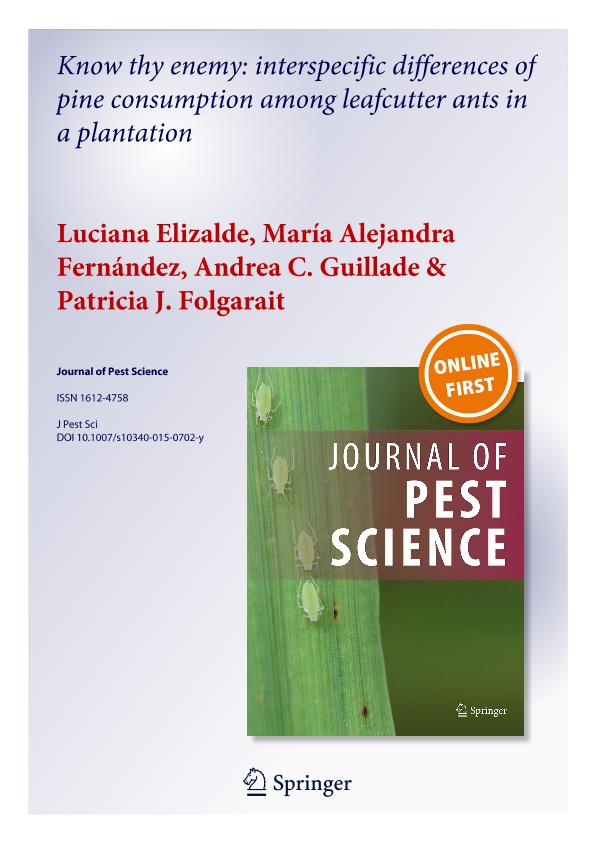Artículo
Know thy enemy: interspecific differences of pine consumption among leafcutter ants in a plantation
Elizalde, Luciana ; Fernández, María Alejandra; Guillade, Andrea Cecilia
; Fernández, María Alejandra; Guillade, Andrea Cecilia ; Folgarait, Patricia Julia
; Folgarait, Patricia Julia
 ; Fernández, María Alejandra; Guillade, Andrea Cecilia
; Fernández, María Alejandra; Guillade, Andrea Cecilia ; Folgarait, Patricia Julia
; Folgarait, Patricia Julia
Fecha de publicación:
06/2016
Editorial:
Springer Heidelberg
Revista:
Journal of Pest Science
ISSN:
1612-4758
Idioma:
Inglés
Tipo de recurso:
Artículo publicado
Clasificación temática:
Resumen
The damage to plantations by pests is often determined by perceptions rather than objective data, resulting in excessive use of pesticides. Leafcutter ants are considered important pests to plantations in America. We evaluated the difference in Pinus taeda biomass consumption by four Acromyrmex leafcutter ant species which co-inhabit plantations of this pine species. These ants exhibit morphological and behavioral differences, i.e., Ac. heyeri has mandibles adapted to cut monocots, while the other species cut dicots, which may result in differences in their consumption of pine. We collected the plant biomass that ants carried into their nests and recorded the foraging activity in different seasons throughout a year. The P. taeda biomass carried into leafcutter nests was less than 20 % compared to total plant biomass. Colonies with greater foraging activity carried a greater amount of total biomass, but they did not carry more pine biomass. The leafcutter ant species studied differed in their use of pine biomass, but not of total biomass. Acromyrmex ambiguus and Ac. crassispinus were the species carrying the greatest amount of pine biomass and with more colonies using pine, whereas very little amounts of pine were carried by Ac. heyeri and by very few colonies. Thus, leafcutter ant species do not cause the same damage to pine plantations. Our results also highlight the importance of pest management strategies based on a thorough knowledge of the biology of the species, including those characteristics which can predict the use that each species will make of the plantation.
Palabras clave:
Acromyrmex
,
Forestation
,
Pest Species
,
Pinus Taeda
,
Species Traits
Archivos asociados
Licencia
Identificadores
Colecciones
Articulos(INIBIOMA)
Articulos de INST. DE INVEST.EN BIODIVERSIDAD Y MEDIOAMBIENTE
Articulos de INST. DE INVEST.EN BIODIVERSIDAD Y MEDIOAMBIENTE
Citación
Elizalde, Luciana; Fernández, María Alejandra; Guillade, Andrea Cecilia; Folgarait, Patricia Julia; Know thy enemy: interspecific differences of pine consumption among leafcutter ants in a plantation; Springer Heidelberg; Journal of Pest Science; 89; 2; 6-2016; 403-411
Compartir
Altmétricas



